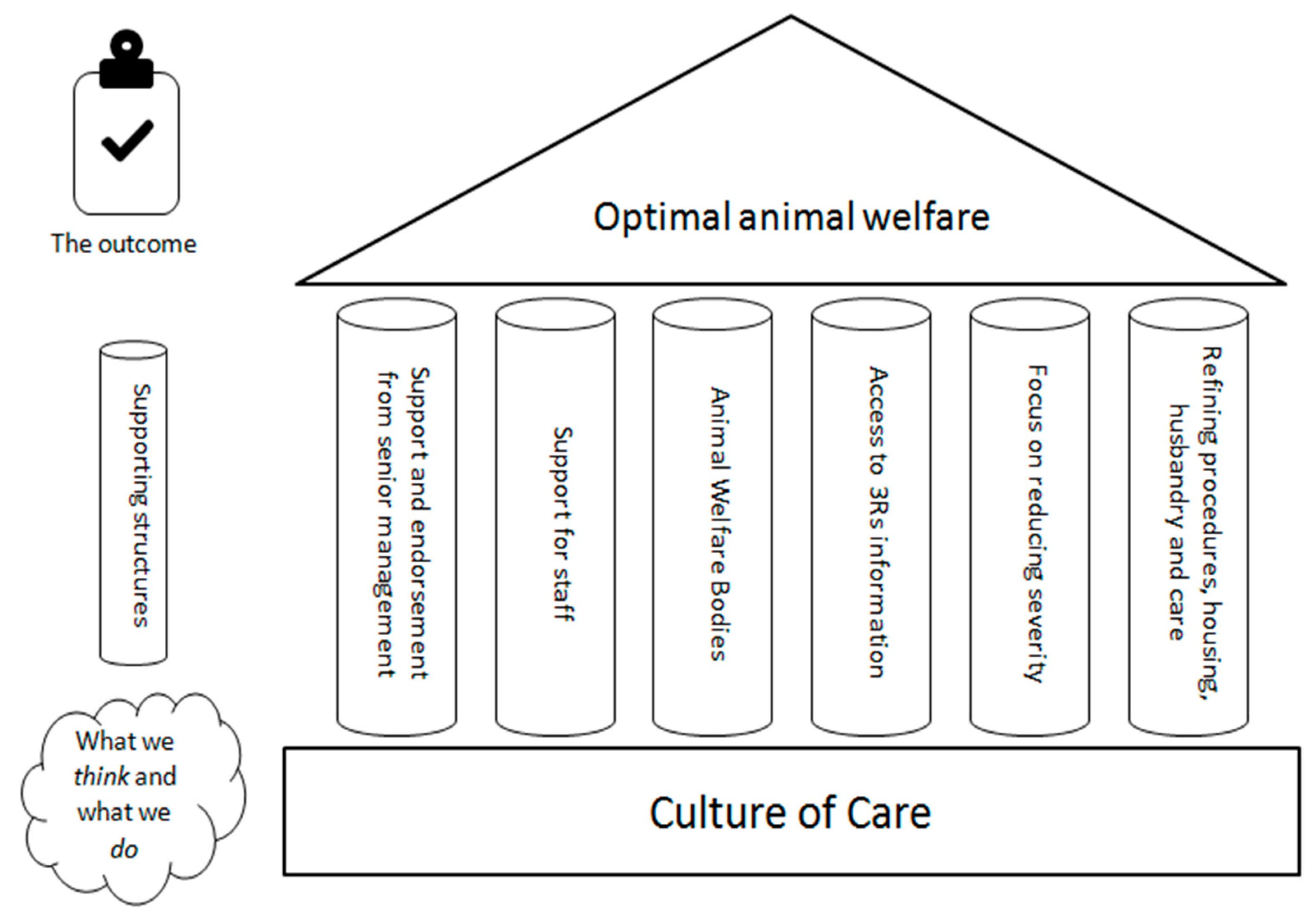3Rs-Related and Objective Indicators to Help Assess the Culture of Care
Simple Summary
Abstract
1. Introduction
2. Assessing the Culture of Care
2.1. 3Rs-Based, Animal-Centric Criteria
2.2. Objective Indicators
3. Conclusions
- Make sure that there are some separate indicators relating to (i) replacement, (ii) refinement, and (iii) reduction, including optimizing experimental design and analysis
- Think about the life-time experience of the animals, how a good Culture of Care should improve this, and how this might translate into indicators you could assess
- Identify some objective indicators (such as animal welfare outcomes, supportive structures, or cultural descriptors) that can be measured or evidenced, e.g., with audit trails
- Review references 3 to 11 for inspiration, and look at the Norecopa Culture of Care page
- Share your assessment protocols, e.g., on your establishment’s website and via articles and blogs, and consider joining relevant discussion groups such as the Culture of Care network, or networks for AWBs, ethics committees, or Institutional Animal Care and Use Committees
Author Contributions
Funding
Conflicts of Interest
References
- Norecopa. Culture of Care. Available online: https://norecopa.no/more-resources/culture-of-care (accessed on 12 September 2019).
- Klein, H.J.; Bayne, K.A. Establishing a culture of care, conscience, and responsibility: Addressing the improvement of scientific discovery and animal welfare through science-based performance standards. ILAR J. 2007, 48, 3–11. [Google Scholar] [CrossRef] [PubMed]
- European Union. Directive 2010/63/EU of the European Parliament and of the Council of 22 September 2010 on the protection of animals used for scientific purposes. Off. J. Eur. Union. 2010, 276, 33–79. [Google Scholar]
- National Research Council. Guide for the Care and Use of Laboratory Animals, 3rd ed.; The National Academies Press: Washington, DC, USA, 2011. [Google Scholar]
- European Commission. A Working Document on Animal Welfare Bodies and National Committees to fulfil the Requirements under the Directive; European Commission: Brussels, Belgium, 2014; Available online: https://ec.europa.eu/environment/chemicals/lab_animals/pdf/guidance/animal_welfare_bodies/en.pdf (accessed on 11 October 2019).
- European Commission. A Working Document on the Development of a Common Education and Training Framework to fulfil the Requirements under the Directive; European Commission: Brussels, Belgium, 2014; Available online: https://ec.europa.eu/environment/chemicals/lab_animals/pdf/Endorsed_E-T.pdf (accessed on 11 October 2019).
- European Commission. A Working Document on Inspections and Enforcement to fulfil the Requirements under the Directive; European Commission: Brussels, Belgium, 2014; Available online: https://ec.europa.eu/environment/chemicals/lab_animals/pdf/endorsed_inspection-enforcement.pdf (accessed on 11 October 2019).
- Bertelsen, T.; Hawkins, P. A Culture of Care. In Animal Centric Management in the Laboratory Animal Facility; Cloutier, S., Gaskill, B., Sorensen., D.B., Eds.; CRC Press: Boca Raton, FL, USA, in press.
- Hawkins, P.; Thomas, R. Assessing the Culture of Care: A Survey of Network Members. 2017. Available online: https://www.researchgate.net/publication/336253708_Assessing_the_Culture_of_Care_a_survey_of_network_members (accessed on 13 November 2019).
- Robinson, S.; Sparrow, S.; Williams, B.; Decelle, T.; Bertelsen, T.; Reid, K.; Chlebus, M. The European Federation of the Pharmaceutical Industry and Associations Research and Animal Welfare Group Reflections on “Culture of Care” in the Context of Using Animals for Scientific Purposes. Lab. Anim. in press.
- Animals in Science Regulation Unit. Identification and Management of Patterns of Low-Level Concerns at Licensed Establishments. 2015. Available online: https://assets.publishing.service.gov.uk/government/uploads/system/uploads/attachment_data/file/512098/Patterns_low-level_concerns.pdf (accessed on 12 October 2019).
- Culture of Care Network. Communication and the Culture of Care. Available online: https://norecopa.no/media/8159/communication-and-the-culture-of-care-from-the-culture-of-care-network.pdf (accessed on 13 September 2019).

| All 3Rs |
|
| Replacement |
|
| Reduction/optimising animal numbers |
|
| Refinement |
|
| Could Be Good or Bad | Good Culture of Care | Poor Culture of Care |
|---|---|---|
|
|
|
|
© 2019 by the authors. Licensee MDPI, Basel, Switzerland. This article is an open access article distributed under the terms and conditions of the Creative Commons Attribution (CC BY) license (http://creativecommons.org/licenses/by/4.0/).
Share and Cite
Hawkins, P.; Bertelsen, T. 3Rs-Related and Objective Indicators to Help Assess the Culture of Care. Animals 2019, 9, 969. https://doi.org/10.3390/ani9110969
Hawkins P, Bertelsen T. 3Rs-Related and Objective Indicators to Help Assess the Culture of Care. Animals. 2019; 9(11):969. https://doi.org/10.3390/ani9110969
Chicago/Turabian StyleHawkins, Penny, and Thomas Bertelsen. 2019. "3Rs-Related and Objective Indicators to Help Assess the Culture of Care" Animals 9, no. 11: 969. https://doi.org/10.3390/ani9110969
APA StyleHawkins, P., & Bertelsen, T. (2019). 3Rs-Related and Objective Indicators to Help Assess the Culture of Care. Animals, 9(11), 969. https://doi.org/10.3390/ani9110969




